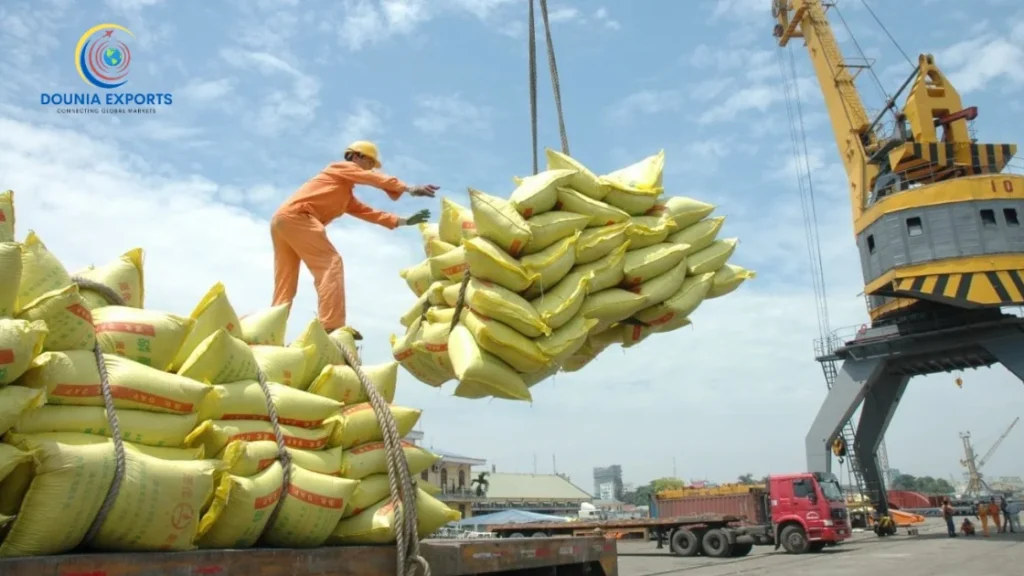In the ever-competitive world of international agriculture, Indian rice exporters have carved out a significant niche, consistently leading the global market. Their success is no accident—it’s the result of a combination of favourable climate, government policies, technological advancements, and strategic market positioning. According to a report by The Economic Times, India’s rice exports have reached record highs of 21.5 million tonnes in recent years, further solidifying the country’s dominance in the global market.
In this blog, we will explore why Indian rice exporters are at the forefront of the international rice trade, provide the latest statistics, and offer a comprehensive guide on how to navigate this thriving market.
The Foundation: Why India Excels in Rice Production
India’s dominance in the rice export market is built on a solid foundation of natural resources and agricultural expertise. The country boasts diverse agro-climatic zones, which are ideal for cultivating various types of rice, from Basmati to non-Basmati varieties. Reuters notes that India has not only maintained but also expanded its leadership position in the international rice trade, thanks to consistent growth in production and export volumes.

The Indian government has also played a crucial role in supporting rice farmers and exporters through subsidies, export incentives, and infrastructure development. For instance, the Pradhan Mantri Fasal Bima Yojana (PMFBY) provides crop insurance, ensuring that farmers can manage risks and maintain consistent production levels. The Hindu BusinessLine highlights how government initiatives have been instrumental in making India the world’s largest rice exporter.
The Global Reach: Indian Rice Exporters’ Strategic Expansion
Indian rice exporters have successfully penetrated a diverse range of international markets, from the Middle East to Europe and Africa to North America. This achievement can be credited to their ability to adapt to changing market demands and comply with stringent international quality standards.
In 2024, India’s rice exports reached a new peak, with over 22 million tonnes shipped worldwide, Representing close to 40% of global rice exports, as reported by the Food and Agriculture Organization. (FAO) This remarkable achievement highlights the strategic importance of Indian rice in the global food supply chain. Rice exporters in India have mastered the art of logistical efficiency, ensuring that Indian rice reaches global destinations quickly and in pristine condition.
Technological Advancements: The Edge in International Rice Trade

One of the key factors that set Indian rice exporters apart is their adoption of cutting-edge technology in both cultivation and processing. From drone-assisted farming to precision irrigation, technology has revolutionised the rice industry in India. This has not only increased yield but also improved the quality of the rice, making it more competitive in the international market.
Moreover, the use of advanced milling techniques and state-of-the-art packaging has ensured that Indian rice meets the highest quality standards required by international buyers. By embracing technology, Indian rice exporters have been able to reduce costs, enhance efficiency, and increase their share in the international rice trade.
Market Trends: Navigating the Global Rice Export Market

As of 2024, the global rice market is experiencing a shift towards premium and organic rice varieties, with consumers increasingly seeking high-quality products. Indian rice exporters have responded by expanding their offerings to include organic Basmati rice and specialty rice varieties, which have gained immense popularity in health-conscious markets like the USA and Europe.
Another significant trend is the rising demand for rice in African countries like Jordan, where Indian rice is preferred for its affordability and quality. Rice exporters in India have strategically focused on these markets, establishing strong distribution networks and building brand loyalty among consumers.
Challenges and Opportunities: A Comprehensive Guide for Indian Rice Exporters
Despite the successes, Indian rice exporters face several challenges, including fluctuating international prices, climate change, and competition from other major rice-exporting countries like Thailand and Vietnam. The World Bank report on India’s role in global agricultural trade highlights the need for exporters to remain agile and continuously adapt their strategies to maintain their competitive edge.
Here’s a comprehensive guide for Indian rice exporters to navigate the global market:
- Diversify Product Range: Expand into premium, organic, and speciality rice markets to cater to changing consumer preferences.
- Strengthen Quality Control: Invest in quality assurance measures to meet international standards and build a reputation for reliability.
- Leverage Technology: Utilize the latest agricultural and processing technologies to enhance efficiency and reduce costs.
- Focus on Emerging Markets: Identify and penetrate new markets with growing demand for rice, such as Africa and Latin America.
- Build Stronger Partnerships: Collaborate with international distributors and retailers to ensure a steady demand for Indian rice.
How Indian Rice Exporters Dominate the Global Market
Indian rice exporters lead the global market by combining advanced agricultural practices, strategic market expansion, and a focus on quality. With a share of nearly 40% in international rice exports, India’s rice industry continues to grow, driven by technology and a commitment to meeting international standards.
The Future of Indian Rice Exports

Indian rice exporters have set the bar high in the global market, and their success story is far from over. With continued innovation, a focus on quality, and a strategic approach to market expansion, the future looks promising for the Indian rice export industry. Whether you’re an aspiring exporter or an established player looking to expand, learning from the leaders in the field—like Dounia Exports—can provide valuable insights into navigating the complex world of international rice trade.
Partner with Dounia Exports
If you’re looking to source high-quality Indian rice that meets international standards, look no further than Dounia Exports. With decades of experience and a commitment to excellence, Dounia Exports is considered the best rice exporter in India and is your trusted partner in the global rice market. Contact us today to learn how we can help you succeed in the competitive world of rice exports.
FAQs for Rice Exporters in India
1. What makes Indian rice exporters so successful in the global market?
Indian rice exporters succeed due to a combination of natural resources, advanced agricultural practices, government support, and strategic market positioning.
2. Which countries import the most Indian rice?
Key importers of Indian rice encompass nations in the Middle East, Africa, and Europe, with a growing demand also emerging from the USA and Southeast Asia.
3. How do Indian rice exporters maintain high quality in their products?
Indian rice exporters use advanced milling techniques, rigorous quality control measures, and state-of-the-art packaging to ensure their products meet international standards.
4. What types of rice are most commonly exported from India?
India primarily exports Basmati and non-Basmati rice, with increasing demand for organic and speciality varieties in premium markets.
5. What challenges do Indian rice exporters face, and how can they overcome them?
Challenges include fluctuating prices, climate change, and competition. Exporters can overcome these by diversifying products, leveraging technology, and focusing on emerging markets.

